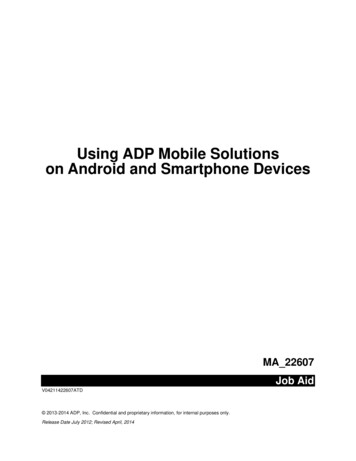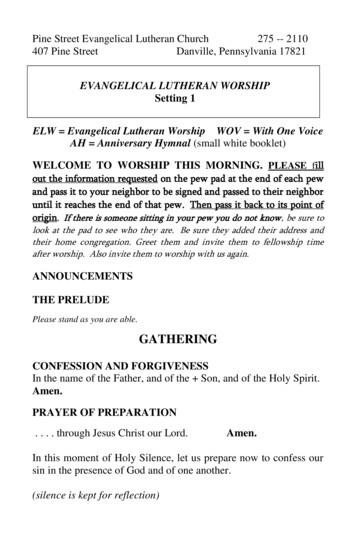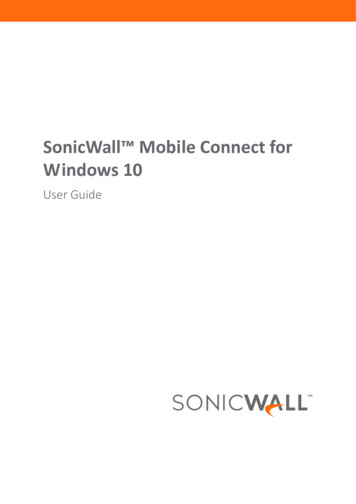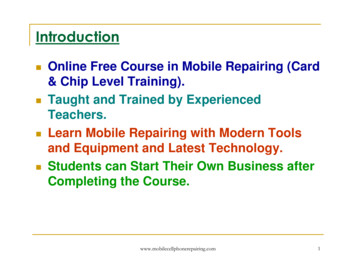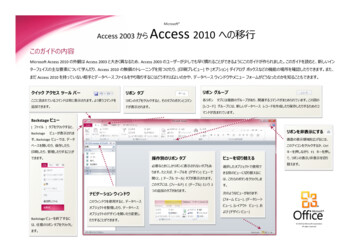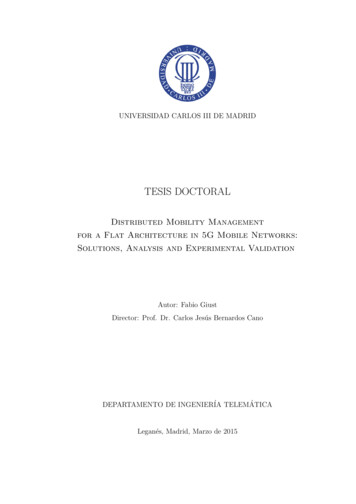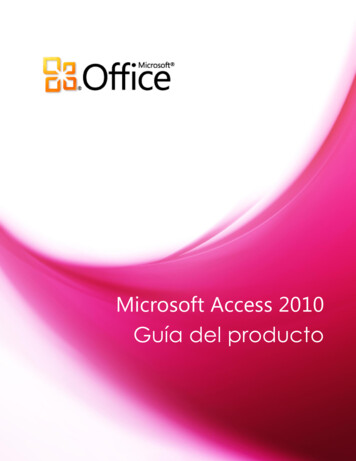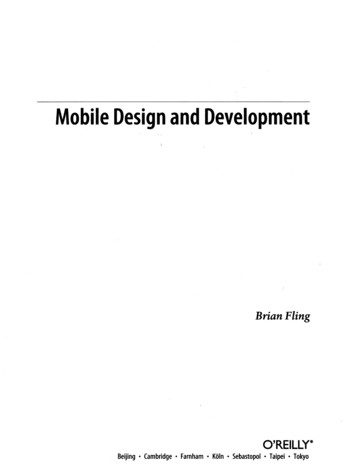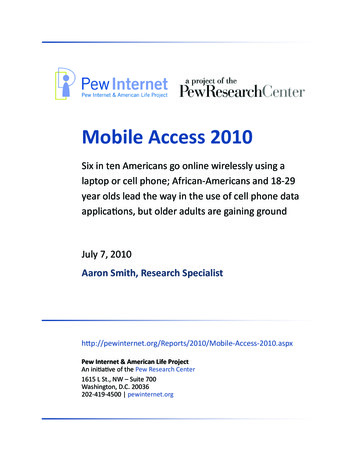
Transcription
Mobile Access 2010Six in ten Americans go online wirelessly using alaptop or cell phone; African-Americans and 18-29year olds lead the way in the use of cell phone dataapplications, but older adults are gaining groundJuly 7, 2010Aaron Smith, Research le-Access-2010.aspxPew Internet & American Life ProjectAn initiative of the Pew Research Center1615 L St., NW – Suite 700Washington, D.C. 20036202-419-4500 pewinternet.org
Summary of FindingsSix in ten American adults are now wireless internet users, and mobile data applications have grown more popular over the last year.As of May 2010, 59% of all adult Americans go online wirelessly. Our definition of a wireless internet userincludes the following activities: Going online with a laptop using a wi-fi connection or mobile broadband card. Roughly half of alladults (47%) go online in this way, up from the 39% who did so at a similar point in 2009. Use the internet, email or instant messaging on a cell phone. Two in five adults (40%) do at least oneof these using a mobile device, an increase from the 32% of adults who did so in 2009.Taken together, 59% of American adults now go online wirelessly using either a laptop or cell phone, anincrease over the 51% of Americans who did so at a similar point in 2009.1Cell phone ownership has remained stable over the last year, but users are taking advantage of a muchwider range of their phones’ capabilities compared with a similar point in 2009. Of the eight mobiledata applications we asked about in both 2009 and 2010, all showed statistically significant year-to-yeargrowth.The use of non-voice data applicationshas grown significantly over the last yearThe % of cell phone owners who use their phones to do the following66Take a picture766572Send or receivetext messagesPlay a game2734Send or receive email2534Access the internetPlay musicSend or receiveinstant messagesRecord a videoApril 2009May 20102538213320301934Source: Pew Research Center's Internet & American Life Project, April 29-May 30, 2010 Tracking Survey.N 2,252 adults 18 and older; n 1,917 based on cell phone users.1Because of changes in question wordings over time, our current wireless internet user definition is not directly comparable to any pre-2009 findings.page 2
This year we also asked for the first time about seven additional cell phone activities. Among all cellphone owners: 54% have used their mobile device to send someone a photo or video 23% have accessed a social networking site using their phone 20% have used their phone to watch a video 15% have posted a photo or video online 11% have purchased a product using their phone 11% have made a charitable donation by text message 10% have used their mobile phone to access a status update service such as TwitterAfrican-Americans and Latinos continue to outpace whites in their use of dataapplications on handheld devices.Continuing a trend we first identified in 2009, minority Americans lead the way when it comes to mobileaccess—especially mobile access using handheld devices. Nearly two-thirds of African-Americans (64%)and Latinos (63%) are wireless internet users, and minority Americans are significantly more likely toown a cell phone than their white counterparts (87% of blacks and Hispanics own a cell phone, compared with 80% of whites). Additionally, black and Latino cell phone owners take advantage of a muchwider array of their phones’ data functions compared to white cell phone owners. It is important to notethat our data for Hispanics represents English-speaking Hispanics only, as our survey did not provide aSpanish-language option.page 3
page 4
Young adults are heavily invested in the mobile web, although 30-49 year oldsare gaining ground.Nine in ten 18-29 year olds own a cell phone, and these young cell owners are significantly more likelythan those in other age groups to engage in all of the mobile data applications we asked about in oursurvey. Among 18-29 year old cell phone owners: 95% send or receive text messages 93% use their phone to take pictures 81% send photos or videos to others 65% access the internet on their mobile device 64% play music on their phones 60% use their phones to play games or record a video 52% have used their phone to send or receive email 48% have accessed a social networking site on their phone 46% use instant messaging on their mobile device 40% have watched a video on their phone 33% have posted a photo or video online from their phone 21% have used a status update service such as Twitter from their phone 20% have purchased something using their mobile phone 19% have made a charitable donation by text messageAlthough young adults have the highest levels of mobile data application use among all age groups,utilization of these services is growing fast among 30-49 year olds. Compared with a similar point in2009, cell owners ages 30-49 are significantly more likely to use a range of mobile data applications on ahandheld device.The mobile data applications with the largest year-to-year increases among the 30-49 year old cohortinclude taking pictures (83% of 30-49 year old cell owners now do this, a 12-point increase from 2009);recording videos (39% do this, an 18-point increase from 2009); playing music (36% do this, a 15-pointincrease); using instant messaging (35% now do this, a 14-point increase); and accessing the internet(43% now do this, a 12-point increase compared with 2009).About the SurveyThis report is based on the findings of a daily tracking survey on Americans’ use of the Internet. The results in this report are based on data from telephone interviews conducted by Princeton Survey ResearchAssociates International between April 29 and May 30, 2010, among a sample of 2,252 adults ages 18and older, including 744 reached on a cell phone. Interviews were conducted in English. For resultsbased on the total sample, one can say with 95% confidence that the error attributable to samplingand other random effects is plus or minus 2.4 percentage points. For results based cell phone owners(n 1,917), the margin of sampling error is plus or minus 2.7 percentage points. In addition to samplingerror, question wording and practical difficulties in conducting telephone surveys may introduce someerror or bias into the findings of opinion polls.page 5
Data about sending photos or videos to others using a cell phone and texting charitable donationsare based on telephone interviews with a nationally representative sample of 1,009 adults living inthe continental United States. Telephone interviews were conducted by landline (678) and cell phone(331, including 104 without a landline phone). The survey was conducted by Princeton Survey ResearchInternational (PSRAI). Interviews were done in English by Princeton Data Source from June 17-20, 2010.Statistical results are weighted to correct known demographic discrepancies. The margin of sampling error for the complete set of weighted data is 3.7 percentage points.page 6
Part One: The current state of wireless internet useAs of May 2010, six in ten American adults (59%) are wireless internet users. Due to the quickly evolvingnature of mobile technologies, our definition of a wireless internet user has changed several times sincewe began studying this topic; throughout this report, a wireless internet user is defined as someone whodoes one or more of the following: Go online from a laptop using a wi-fi or mobile broadband internet connection. 86% of laptop owners go online in this way, which represents 47% of all American adults. Use the internet, email or instant messaging from a cell phone. Half (49%) of cell phone owners doat least one of these on their mobile device, which works out to 40% of all adults.The 59% of American adults who do at least one of these activities represents an eight-point increaseover the 51% of American adults who did so in our April 2009 wireless internet survey, and wireless access using both cell phones and laptops has grown significantly on a year-to-year basis.2 The remaining41% of Americans includes those who are internet users but do not go online wirelessly (22%) as well asthose who are not internet users (19%).Wireless internet use, 2009-2010The % of all adults who do the followingApril 2009395147Go onlinewirelessly withlaptopMay 2010325940Go onlinewirelessly withcell phoneGo onlinewirelessly fromcell or laptopSource: Pew Research Center's Internet & American Life Project,April 29-May 30, 2010 Tracking Survey. N 2,252 adults 18 andolder. Cell phone wireless users include those who use email ona cell phone; use the internet on a cell phone; or use instantmessaging on a cell phone.2While our 2009 report on “Wireless Internet Use” found that 56% of Americans went online wirelessly, that figureincluded several access methods (such as using a wireless network with a desktop computer) that were not asked in this survey.The 51% number cited above represents only the proportion who went online wirelessly using a cell phone or laptop computer.Due to changes in question wording over time, 2009 is the only year with directly comparable data to our 2010 findings.page 7
Laptop computers and cell phones are the primary way Americans go online wirelessly. When we includeother devices (such as mp3 players, e-book readers or tablet computers) in our definition of wireless internet usage, total usage increases by just one half of one percentage point. These other devices will bediscussed individually in more detail in Part Three: Mobile access using laptops and other devices.This eight point year-to-year increase in wireless internet usage is reflected across a fairly broad rangeof demographic groups, with 18-29 year olds and those with a household income of less than 30,000per year showing the greatest increases on a percentage point basis. Wireless internet usage remainedflat for only a small number of groups, such as Latinos and those older than 50—although in contrast toolder Americans, Latinos continue to have high overall rates of wireless adoption. In interpreting thesefigures, it is important to keep in mind that our survey did not provide a Spanish-language option so alldata for Hispanics represents English-speaking Hispanics only.3These higher rates of growth in wireless internet use by whites and African-Americans compared withLatinos are largely a function of laptop adoption. Rates of laptop ownership have grown dramaticallyamong African-Americans in the last year (from 34% in 2009 to 51% in 2010) and moderately amongwhites (from 47% to 55%). By contrast, laptop ownership among English-speaking Latinos has remainedflat over that time (54% of Latinos currently own a laptop computer, compared with 56% who did so in2009).3Language proficiency has a strong association with technology use—for more information on internet adoption andtechnology use among Latinos, see http://pewhispanic.org/reports/report.php?ReportID 119page 8
page 9
Wireless internet users are evenly split between those who access the internet wirelessly using only onedevice (a total of 53% of wireless users go online using either a cell phone or a laptop, but not both) andthose who do so using both a laptop and a mobile phone (47% of wireless users). Additionally, manywireless users take advantage of stationary technologies—70% of wireless internet users own a desktopcomputer, and 57% own a home gaming console such as an Xbox or PlayStation.The composition of the wireless population59% of Americans go online wirelessly using a laptop or cell phone; this ishow they access the mobile webCell phoneonly20%47%LaptoponlyCell phoneand laptop33%Source: Pew Research Center's Internet & American Life Project, April 29-May 30, 2010 Tracking Survey. N 2,252adults 18 and older; n 1,238 based on wireless internet users. Cell phone wireless users include those who useemail on a cell phone; use the internet on a cell phone; or use instant messaging on a cell phone.Several groups have relatively high rates of cell phone internet use. Some of these include: African-Americans and Latinos – 18% of blacks and 16% of English-speaking Hispanics are cell-onlywireless users, compared with 10% of whites. In total, roughly half of African-Americans (54%) andHispanics (53%) go online from a mobile phone. Young adults – 19% of 18-29 year olds are cell-only wireless users, compared with 13% of 30-49 yearolds, 9% of 50-64 year olds and 5% of those ages 65 and older. In total, two-thirds of 18-29 year olds(65%) are cell phone internet users and 84% go online using either a cell phone or a laptop with awireless internet connection. Those with low levels of income and education – 17% of those earning less than 30,000 per yearare cell-only wireless users, as are 20% of those who have not graduated from high school and 15%of those who have graduated high school but have not attended college. The affluent and well-educated have higher overall levels of wireless internet use due to their much higher rates of ownershipand use of laptop computers.Seniors are currently the group with the lowest levels of wireless internet usage. Eight in ten seniors(those ages 65 and older) are either internet users who do not go online wirelessly (24%) or not online atall (56%).page 10
In the rest of this report, we will take a more detailed examination of wireless access using mobilephones (Part Two: Internet use and data applications using mobile phones) and laptop computers andother devices (Part Three: Mobile access using laptops and other devices).page 11
Part Two: Internet use and data applications usingmobile phonesThe use of mobile data applications has grown dramatically over the last year,even as overall cell phone ownership has remained steadyEight in ten American adults (82%) currently own a cell phone of some kind, a figure that has remainedfairly stable over the past year. Since a similar point in 2006, the proportion of Americans with a mobilephone has risen by nine percentage points.While overall mobile phone ownership has not grown over the last year, cell owners now take advantageof a much wider range of their phones’ capabilities. Compared to when we asked these questions in April2009, mobile phone owners are significantly more likely to use their phones to take pictures (76% nowdo this, up from 66% in April 2009); send or receive text messages (72% vs. 65%); play games (34% vs.27%); send or receive email (34% vs. 25%); access the internet (38% vs. 25%); play music (33% vs. 21%);send or receive instant messages (30% vs. 20%); and record a video (34% vs. 19%).The use of non-voice data applicationshas grown significantly over the last yearThe % of cell phone owners who use their phones to do the following66Take a picture766572Send or receivetext messagesPlay a game2734Send or receive email2534Access the internetPlay musicSend or receiveinstant messagesRecord a videoApril 2009May 20102538213320301934Source: Pew Research Center's Internet & American Life Project, April 29-May 30, 2010 Tracking Survey.N 2,252 adults 18 and older; n 1,917 based on cell phone users.page 12
Along with these eight activities, we also asked about seven additional cell phone data applications forthe first time in our 2010 survey.4 Among all cell phone owners: 54% have used their mobile device to send someone a photo or video 23% have accessed a social networking site using their phone 20% have used their phone to watch a video 15% have posted a photo or video online 11% have purchased a product using their phone 11% have made a charitable donation by text message 10% have used their mobile phone to access a status update service such as TwitterYoung adults are much more likely than their elders to use mobile data applications, but cell phone access is becoming more prevalent among 30-49 year oldsPicture-taking and texting are near-ubiquitous among young adult cell phone owners. Fully 95% of cellowning 18-29 year olds use the text messaging feature on their phones, and 93% use their mobile devices to take pictures. Since nine in ten young adults own a cell phone, that means that 85% of all 18-29year olds text, and 83% take photos using a cell phone. Young adult cell phone owners are significantlymore likely to do all of the other mobile data applications we asked about in our survey relative to oldercell owners—often by fairly dramatic margins.54Data about sending photos or videos to others and texting charitable donations were asked on a separate survey (seeMethodology for more information) and are discussed individually in more detail later in this chapter.5For comparable data among teens, please see “Teens and Mobile Phones” (2010): le-Phones.aspxpage 13
Although young adults are significantly more likely than all other age groups to use non-voice data applications on their mobile devices, these services are growing more popular among older adults (specifically, those ages 30-49). Compared with a similar point in 2009, cell owners ages 30-49 are significantlymore likely to use their mobile phone to: Take pictures (83% of cell owners ages 30-49 now do this, compared with 71% in April 2009) Send or receive text messages (82% vs. 75%)page 14
Access the internet (43% vs. 31%) Record a video (39% vs. 21%) Send or receive email (37% vs. 30%) Play music (36% vs. 21%) Send or receive instant messages (35% vs. 21%)Out of the eight mobile data activities we measured in both 2009 and 2010, playing games was the onlyone for which 30-49 year olds did not experience significant year-to-year growth—37% of cell ownersages 30-49 currently play games on a mobile phone, compared with the 32% who did so in 2009.Minority Americans continue to outpace whites in their use of cell phone dataapplicationsAs we found in previous research on this topic,6 minority cell owners are significantly more likely thanwhites to use most non-voice data applications on their mobile devices. They also take advantage of awider range of mobile phone features compared with whites. On average, white cell phone owners use3.8 of the thirteen activities we measured, while black cell owners use an average of 5.4 and Englishspeaking Latinos use an average of 5.8 non-voice data applications.6See “Wireless Internet Use” (2009): ternet-Use.aspxpage 15
Additional mobile data applications – sharing multimedia content and textingcharitable donationsIn a separate survey, we asked about two additional mobile activities—half of cell owners (54%) haveused their mobile device to send a photo or video to someone else, and one in ten (11%) have made acharitable donation by text message.page 16
As with the other mobile data applications discussed above, both of these activities are particularly common among young cell owners and minority Americans (particularly Latinos). Fully 81% of cell ownersages 18-29 have used their phone to send a photo or video to someone else, significant higher the proportion of cell owners ages 30-49 (63%), 50-64 (40%) or 65 (18%) who have done so. Young cell ownersare also more likely than cell owners in other age groups to make a charitable donation using the textmessaging feature on their phones (19% of cell owners ages 18-29 have done so, compared with 10% of30-49 year olds, 8% of 50-64 year olds and just 4% of cell owners 65 and up).In terms of racial/ethnic comparisons, Latino cell phone owners are especially likely to do both of theseactivities using their mobile devices. Among cell owners, 70% of English-speaking Latinos have sentsomeone a photo or video (compared with 58% of African-Americans and 50% of whites) and 23%have made a charitable donation via text message (compared with 16% of African-Americans and 7% ofwhites).More than half of mobile web users go online from their phones on a daily basisIn addition to being a growing proportion of the overall cell phone population, users of the mobile webnow go online more frequently using their handheld devices than they did as recently as last year. Morethan half of all mobile internet users go online from their handheld devices on a daily basis—43% do soseveral times a day, and 12% do so about once a day. At a similar point in 2009, just 24% of mobile internet users went online several times a day.More than half of cell phone internet usersgo online daily from their mobile deviceFrequency of cell phone internet use among those who go online from acell phone (% of adult cell phone internet users)April 2009433937252412Several timesa day1512About oncea day1093-5 daysa week15 1381-2 daysa weekSource: Pew Research Center's Internet & American Life Project, April 29-May 30,2010 Tracking Survey. N 2,252 adults 18 and older; n 772 based on those whouse a cell phone to access the internet.page 17May 2010September 2009279Every fewweeks or less
Among mobile internet users, frequency of use is highest among the affluent and well-educated, as wellas Latinos. Among those who go online using a handheld device 55% of English-speaking Hispanics, 52%of college graduates and 56% of those with a household income of 75,000 or more per year use theircell phone to go online several times a day. Young adults are also intense mobile internet users—52% ofthose ages 18-29 who go online using a cell phone do so several times a day, and an additional 17% doso about once a day—although 43% of mobile web users ages 30-49 go online multiple times a day.page 18
Part Three: Mobile access using laptops and other devicesNearly as many Americans now own laptops as own desktops, and just underhalf of all adults use a laptop to go online wirelesslyAs of May 2010 55% of all American adults own a laptop computer. This is the first time since the PewInternet Project began surveying laptop ownership that more than half of all adults own a laptop computer, and represents an eight percentage point increase since a similar point in 2009. Laptops are nownearly as common as desktop computers—62% of American adults now own a desktop computer, afigure that is relatively unchanged on a year-to-year basis and down slightly from the 68% of adults whoowned a desktop computer in the spring of 2006. As we have found in previous research,7 18-29 yearolds are one of the few groups more likely to own a laptop (70% of 18-29 year olds do so) than a desktop(61%), although 30-49 year olds are rapidly approaching that point as well (66% of 30-49 year olds own adesktop, compared with 63% who own a laptop computer).Desktop and laptop ownership, 2006-2010The % of all adults who own a desktop or laptop urce: Pew Research Center's Internet & American Life Project, April 29-May 30,2010 Tracking Survey. N 2,252 adults 18 and older; n 1,238 based on wirelessinternet users. Cell phone wireless users include those who use email on a cellphone; use the internet on a cell phone; or use instant messaging on a cell phone.Not all laptop owners use their laptops to go online wirelessly, although the vast majority (86%) do so,using either a wi-fi or mobile broadband connection. That works out to 47% of all adults who use a lap7See “Social Media and Young Adults” (2010), Part 2: nd-YoungAdults/Part-2/2-Computers.aspx?r 1page 19
top to connect wirelessly to the internet. Both of these represent a statistically significant increase fromwhat we found at a similar point in 2009. At that time, 82% of laptop owners (representing 39% of alladults) went online wirelessly using a laptop computer.Connecting via a wi-fi connection is by far the most common way laptop owners access the wirelessinternet. More than eight in ten laptop owners (84%) use wi-fi to go online, and one-quarter (23%) doso using mobile wireless broadband.8 There is some overlap between these two technologies, as aroundone in five laptop owners (22%) use both wi-fi and mobile wireless broadband to go online.Laptop ownership and mobile usage is most concentrated among the college educated, those youngerthan age 50 and those earning 50,000 or more per year. There are no major differences when it comesto race or ethnicity—blacks and English-speaking Hispanics are just as likely as whites to own a laptop,and to access the internet on a laptop using a wireless connection. Notably, laptop ownership and usageamong African Americans has grown significantly since 2009; half (51%) of all black adults now own alaptop computer, up from the 34% who said this in our April 2009 survey.8Note: because multiple responses were allowed, totals may sum to more than 100%.page 20
page 21
Most wireless laptop users go online from multiple locationsLaptop owners utilize the portable nature and wireless capabilities of these devices to go online froma range of locations. Among those who use their laptop to go online wirelessly (using either a wi-fi ormobile broadband card) 86% do so at home, 37% do so at work, and 54% do so someplace other thanhome or work. Six in ten wireless laptop users (61%) go online from more than one of these locations,with two in five (20%) using their laptop to access the internet from all three locations (home, work andsomewhere else).Overall, there are relatively few demographic differences among laptop owners when it comes to wherethey use their devices to access the internet. The primary differences relate to access at work. Amongwireless laptop users: 43% of those with some college experience go online using a laptop at work, compared with 22% ofthose with a high school degree or less. 49% of those earning 75,000 or more per year go online using a laptop at work, compared with 30%of those earning less than 75,000 per year. 41% of men go online using a laptop from work, compared with 32% of women.Mobile access using other devicesDevices other than laptop computers and mobile phones also play into the wireless internet story, as9% of American adults now go online using an mp3 player, e-book reader or tablet computer. However,these devices largely play a supporting role for Americans who already access the internet wirelesslyusing a laptop computer or cell phone. The addition of these devices to our wireless internet definitionadds only one half of one percentage point to the overall wireless internet usage figure discussed above.Put another way, just 1% of Americans who do not go online wirelessly using a laptop computer or cellphone use some other type of mobile device to access the internet. By contrast, 15% of wireless internetusers also use some other type of mobile device to go online in addition to a cell phone and/or wirelesslaptop.Mp3 players – Nearly half of all American adults (46%) own an mp3 player, and 16% of them use theirhandheld music players to go online. Not surprisingly, mp3 player ownership is strongly correlated withage: three-quarters (73%) of 18-29 year olds own this type of device, compared with 56% of 30-49 yearolds, 33% of 50-64 year olds and just 7% of those ages 65 and older. Among mp3 player owners, men areslightly more likely than women to use their device to go online (19% vs. 14%), while internet use is alsorelatively high among 18-29 year olds (22% of mp3 owners in this age group use their player to accessthe internet).E-book readers – 4% of Americans own an e-book reader like a Kindle, and nearly half (46%) of theseowners use their electronic book reader to access the internet. At the moment e-book readers arelargely a luxury item owned primarily by the well-off and well-educated, as one in ten college graduates(9%) and 8% of those with an annual household income of 75,000 or more per year own an electronicbook reader. The number of individuals in our survey who go online using e-book readers is too small fordetailed demographic comparisons of internet use on this device.Game consoles – 42% of Americans own a game console like an Xbox or Play Station, and 29% of console owners use their gaming device to access the internet.9 Young adults are more likely than average9Note: we did not ask respondents to specify whether this internet access involved a wired or wireless network, so thispage 22
to own a game console (62% of 18-29 year olds do so) as are parents (67%) and those ages 30-49 (56%).Although men and women are equally likely to own a gaming console, men are much more likely to usethem to go online (38% of male console owners do so, compared with 20% of women). Additionally,nearly half of console owners ages 18-29 (45%) use their gaming to device to access the internet.Tablet computers – This year for the first time we asked our respondents whether they owned a tabletPC such as an iPad, and 3% said that they do. Roughly six in ten of these individuals use their device toaccess the internet, although given the small number of tablet owners these findings are not reported indetail here.figure is not included in any of the wireless internet usage figures calculated in this report.page 23
Final ToplineSpring Change Assessment Survey 20106/4/10Data for April 29 – May 30, 2010Princeton Survey Research Associates Internationalfor the Pew Research Center’s Internet & American Life ProjectSample: n 2,252 national adults, age 18 and older, including 744 cell phone interviewsInterviewing dates: 04.29.10 – 05.30.10Margin of error is plus or minus 2 percentage points for results based on Total [n 2,252]Margin of error is plus or minus 3 percentage points for results based on internet users [n 1,756]Margin of error is plus or minus 3 percentage points for results based on cell phone users [n 1,917]Q10As I read the following list of items, please tell me if you happen to have each one, ornot. Do you have [INSERT ITEMS IN ORDER]?a.YESNODON’T KNOWREFUSEDCurrent6238**January 20
Mobile Access 2010 Six in ten Americans go online wirelessly using a laptop or cell phone; African-Americans and 18-29 . access—especially mobile access using handheld devices. Nearly two-thirds of African-Americans (64%) and Latinos (63%) are wireless internet users, and minority Americans are significantly more likely to .
